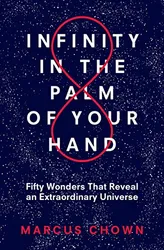This book is a collection of interesting and unusual scientific facts, along with explanations. The author has picked topics of the thought-provoking and mind-blowing variety covering fundamental physics, astronomy, cosmology, biology and others. A lot of them are physics related, so there is quite a bit of quantum mechanics and general relativity, which is always good for a mind-expanding ponder. Each short chapter starts with a strange assertion (like “Today’s sunlight is 30,000 years old”) and then goes on to explain the science behind this statement. In such short chapters, it doesn’t go deeply into the science, but the author does a good job of simplifying the science enough to make it an engaging and interesting read, and there are good diagrams where appropriate.
The book is well organised and easy to read, and the explanations of sometimes tricky physics are really good. A lot of physics, especially topics like quantum mechanics, are pretty difficult to describe in words without using equations and the author does a good job here. The diagrams throughout are really clear and add to the explanations. There are some fun sentences which actually make sense in the context of the book, like the idea of “tiny supermassive black holes”.
The footnotes for each chapter (which are located at the end of the book) are interesting enough that I had to keep flipping back and forth to read them all, which does make me wonder if they should just have been included in the chapters themselves.
Some of the facts seem a bit tenuous. For example “if the sun were made of bananas, it would not make any difference”. The author’s argument is that the heat of the sun comes from the gravitational squashing down of all the mass in the sun, so the mass of the sun in bananas would give the same temperature as the mass of the sun in hydrogen and helium.
According to Wikipedia, the sun is 73.46% Hydrogen, 24.85% helium, 0.77% oxygen and 0.29% carbon. A banana is 75% water, consisting of 2 hydrogen atoms for every oxygen atom, then some sugars which are mostly going to be be carbon and hydrogen. Very roughly that would mean a banana sun would be 0% helium, about 30% oxygen, with quite a bit more carbon than there is currently, and the rest hydrogen. We know that the energy output and behaviour of stars changes as they fuse their hydrogen nuclei into helium, and then heavier elements, eventually using up all their fuel and dying. I would expect that changing the composition of the sun in this way would have an enormous effect on the nuclear reactions going on within the sun’s core. To say that it would make no difference seems unlikely to me! Now I may well be wrong about this, but I could have done with a bit more convincing on this one, or at least an explanation of why the atomic composition of the sun doesn’t matter in this case.
There are some leaps of logic with vague definitions that I didn’t like. I think the author relies on some hand-wavy language in chapter 34, about some of the implications of Special Relativity. He talks about the idea of a “common past”, saying that it doesn’t exist, without ever defining what he means by it.
If two observers shook hands, then went off in different directions at different speeds then they could both agree that the handshake had happened in the past. I would argue that they do share a common past in that case. At some point previously they were together, shaking hands, and they both agree that it happened. What they wouldn’t be able to agree on is exactly how long ago the handshake occurred. Due to the time dilation effect of special relativity, for one observer less time would have passed than for the other. So maybe the author means that, in order to share a common past, two participants in an event must agree how long ago that event occurred. But he doesn’t make this clear.
I am nit-picking a bit here, and the very fact that these chapters caused me to disagree and think about these problems myself means they must be thought-provoking, which I think is the author’s main aim. So in that regard, it’s a success.
If you enjoy being reminded of the limits of our knowledge and how strange the universe really is, then I think you would enjoy this book.
